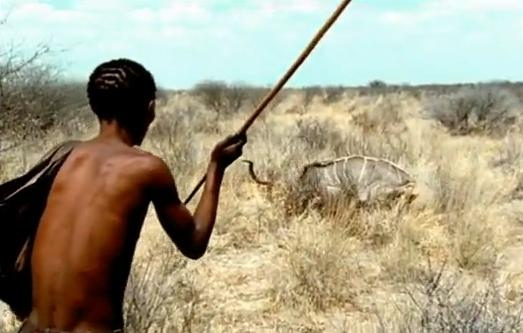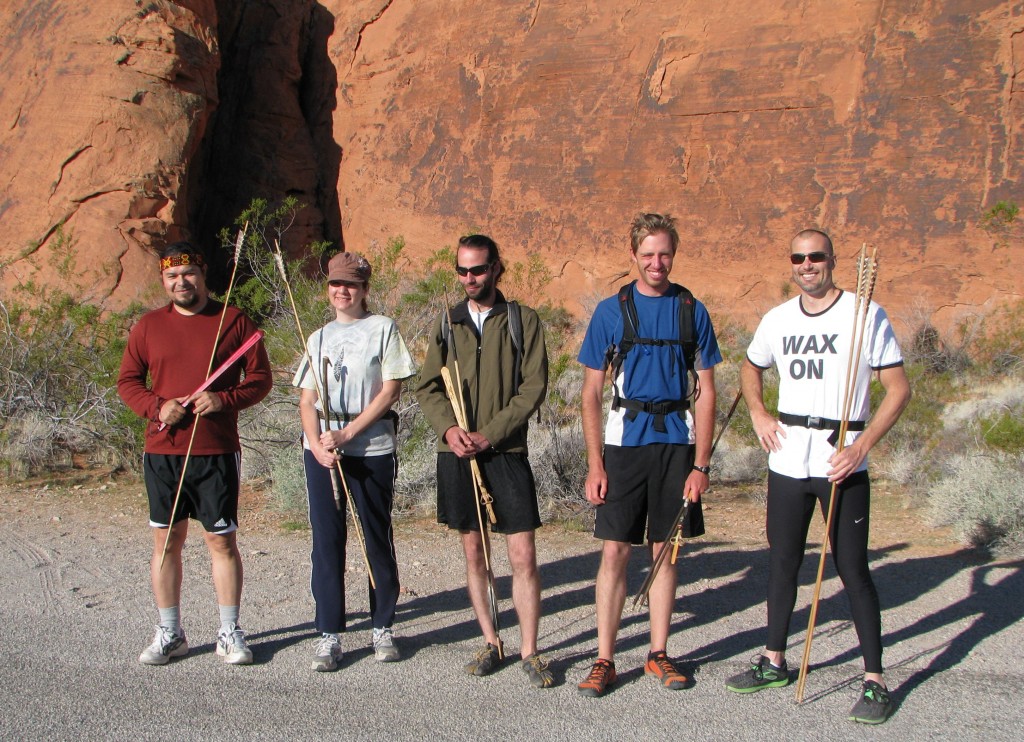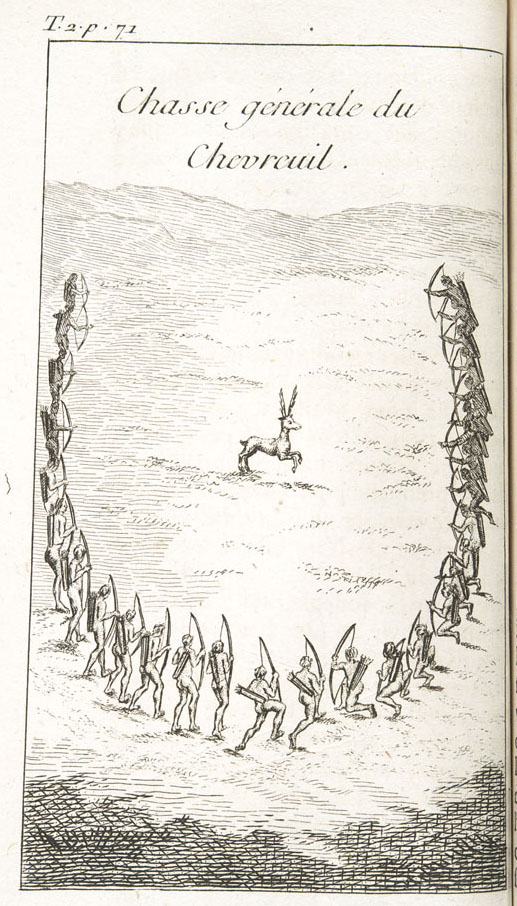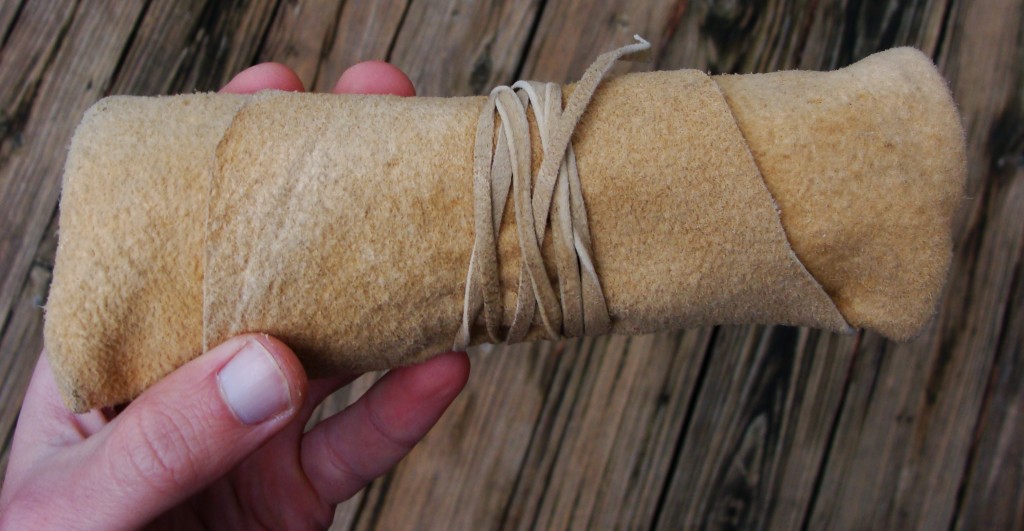Devin B. Pettigrew and Justin Garnett
2/4/2012
History
Persistence Hunting is a method in which human hunters both run and track prey over long distances, and in this way run the animal to overheated exhaustion where it can easily be caught and dispatched. Recent research suggests persistence hunting may have played an important role in the evolution of the genus Homo (Carrier, 1984; Heinrich, 2001; Bramble and Lieberman, 2004; Liebenberg, 2006; Lieberman et al, 2007). Many would suspect that endurance running to capture game would be far too inefficient, concerning energy expenditure to intake ratios, however compared to their quadruped prey humans are highly efficient distance runners. Liebenberg’s research among modern !Xo and /Gwi persistence hunters of the central Kalahari reveals this method to be among their most dependable. For instance, after several failed attempts to stalk kudu with bow and arrow, the hunters resorted to running an animal down (Liebenberg, 2006:1022).

Figure 1. Karoha of Lone Tree in the central Kalahari prepares to deliver the final blow to an exhausted kudu (clip from Attenborough’s Life of Mammals, on BBC Earth. http://youtu.be/826HMLoiE_o).
Persistence hunting was certainly not restricted to Africa. In North America historical accounts show the importance and popularity of running down game among many Native American cultures, as well as running for sport, war, ceremony, travel and communication (Nabokov, 1981; Heinrich, 2001; See also Carrier, 1984:483). Apart from true persistence hunts, other forms of running-hunting involved drives and chasing animals into nets or other closures. Large ‘C’ shaped corrals with walls of piled brush have been recorded in Western states, into which runners drove herds of antelope where the animals could be chased in circles by relay (Frison, 2004). Le Page du Pratz, the early French historian living among the Natchez in modern day Mississippi, recorded a communal hunt in which a large group of young hunters chased deer in a wide ‘C’ formation. The frightened deer exhausted itself more quickly than the hunters by running in a zigzag between the outer walls of the formation (figure 2) (Du Pratz, 1775).
There should be little doubt that these concepts have deep roots in North American prehistory. Replications of Late Archaic atlatl tool kits may support this. From the Basketmaker caves of the Southwest, north to Spring Creek Cave in central Wyoming and west to the Ozark bluffs, perishable atlatl equipment of similar makeup and fairly small calibers have been recovered (see relative pages in the Replications section). These short, light darts are finicky, though with proper tuning and technique they function superbly. Big game may be out of the question, as these calibers most likely max out on medium sized game such as deer and antelope. On those animals, care must be taken to make a good shot to the vitals, which is much easier at ranges within 15 meters or closer.
Furthermore, the Archaic atlatl tool kits included composite darts with removable tips. These foreshafts expand the atlatl tool kit while simultaneously reducing its mass. Broken points can be immediately replaced and a variety of tips can be carried, such as bone and wood blunts for small game, so that the hunter may carry only 2 to 4 mainshafts but is thus prepared for a variety of situations (figure 3) (LaRue 2010:19). This would be very handy for opportunistic hunters. Liebenberg often observed the Kalahari Bushmen changing tactics and even focus to other quarry in the middle of a hunt (2006:1022).

Figure 3. Reproduction of a Basketmaker hunting package, by Pettigrew. Note modern field points for target shooting.
But most importantly, travel is much easier with a small number of light, short mainshafts with their dangerous tips removed. Our initial trials in running with Basketmaker atlatls and darts have shown the equipment to be easy, and even pleasurable to carry in hand on long trail runs. In short, Archaic North American atlatl tackle seems ideally suited to highly mobile warriors or hunters who consistently utilized tactics to get in close to medium game, and prepared themselves for a variety of situations with a lightened and diversified weapons kit.
The Challenge
With this in mind, we are proposing to introduce a new category to the modern sports of distance running and atlatl throwing, by combining the two. The Persistence Hunter’s Challenge involves a run of either a half or full marathon with atlatl and darts in hand, culminating in an accuracy competition. As a safety precaution, foreshafts are required to be removed from the dart mainshafts during the run, and either carried on the runner in a safe location or left at the finish point. Fitting a tip into a dart at any point during the run will result in immediate disqualification.
This competition is designed to be as much a study as a fun contest. The distance of a half or full marathon mimics the average distances of successful persistence hunts noticed by Liebenberg. Partaking in an accuracy competition at the end of a long run will test the atlatlist’s capabilities under tiring circumstances. Furthermore, the ability of the runner to carry atlatl equipment in hand over long distances will be tested, perhaps leading to consideration of certain design aspects of ancient hunting tackle. The only thing missing from the challenge are the mental skills needed for tracking game.
Scoring
The standard Persistence Hunter’s Challenge will be scored using a combination of the runner’s time per minute in the completion of the running portion and the score attained in the atlatl accuracy portion. Non-standard scoring is also allowable, where the target is different (For instance, a 3D or 2d animal or silhouette target, milk jug, coffee cup, etc) or the course is different (i.e. 5k, standard marathon, ultramarathon), or the throwing distances are different, or any combination of the above conditions. Scoring of such non-standard events will be elective, and to the discretion of the game administrator.
- Distance:
The standard distance of the running portion will be a half marathon, 21.08km or 13.1 miles.
- Target:
The standard target will be a 40 centimeter FITA (Fédération Internationale de Tir à l’Arc) paper target face.
- Scoring of running portion:
The running portion will be scored by taking runner’s time from the starting line to the finish line, in minutes, and dividing it by the length of the course in miles (13.1) to obtain an average speed in minutes per mile. This minute-per mile rate is the running score. For instance, a runner completing the course in 2 hours 8 minutes will have done so in 128 minutes: 128/13.1=9.77 minutes per mile.
- Scoring of atlatl accuracy portion:
Course: The standard throwing portion will be thrown at two distances, 8 meters and 10 meters, to represent realistic throwing distances in a persistence hunting scenario. 10 throws will be made in total, 5 from 8 meters and 5 from 10 meters.
The FITA target consists of 10 concentric, colored rings, scored from 1 point (outermost ring) to 10 (innermost ring) with a central “X” ring within the 10 to be used as a tiebreaker. Hits which cut rings will be scored to the highest ring. Misses will be recorded, to be denoted as “M” on the scoring card. Therefore a contestant throwing a round in which they hit the seven ring eight times, the X ring once, and missing once will have a score of 66XM. A competitor throwing five 10s, an 8, two 6s and 2 misses will have a score of 70MM. Dart tip diameter will not exceed 18 millimeters. Throws in which the competitor’s foot crosses the throwing line will not be counted toward the contestant’s score.
- Combining, scoring for the event:
The score of the atlatl throwing portion will be subtracted from 100, and all suffix letters (Xs and Ms) retained. For instance, a score of 70XXM will become 30XXM. The inverted score will then be multiplied by 0.5. The running portion score (Minutes per mile) will then also be multiplied by 0.5, and the two added together, thusly:
A competitor running score was 8 minutes per mile: 8 x 0.5 = 4
The competitor has a throwing score (inverted, as above) of 25XX: (25XX) x 0.5 = 12.5XX
The two scores are then added: 12.5XX + 8 = 20.5XX
The faster a competitor completes the course the lower their minute per mile score, and the more accurate a competitor’s throwing in the accuracy portion the lower the inverted score for that portion. Therefore, a competitor can have a lower score in one portion, an exceptional score in the other, and still win the event.
The 2012 Valley of Fire Event
This year on April 1, 2012, The Valley of Fire State Park in Nevada will host the first ever Persistence Hunter’s Challenge. The run will be made over a 13 mile trail loop through the park beginning and ending at the famous Atlatl Rock, where ancient petroglyphs of Basketmaker atlatls can be seen. In addition, 1 mile and 5K runs will be included for those wishing to take part in a shorter distance. The Valley of Fire is a beautiful and very fitting place to kick off this event, and we would encourage anyone interested in the ancient, lost art of persistence hunting to attend.
Participants must register for the event by March 21st. See the event brochure for more information: Atlatl Endurance Challenge.
Acknowledgments: We would like to thank Amber Heman of the Valley of Fire State Park for her help in putting together the coming event at the Park, and Melainia McClain for helping design the scoring method.
Update 2/12/2013
Last year’s event went very well. Brian (?) from Las Vegas, Nevada heard of the event and showed up to run with Pettigrew and Garnett on the half marathon. Salvador Ochoa and Aimee Dozois ran the 5k and 1 mile run respectively. The trails led around the sandstone outcropping where Atlatl Rock is located, with the longer trail making a loop around the valley following dim hiking trails and washes. The throw at the end of the run was made on 3d animal targets lying down to simulate exhausted prey. The three of us running the half marathon decided to make the run as a group, so there were no “winners” in this contest, only camaraderie. Despite extremely windy conditions which made accuracy in the throw difficult, all participants felt that accuracy could be achievable after a long run. Brian even scored a hit on a longer throw, having never used an atlatl before in his life. The atlatl gear was easy, even pleasurable to carry on the run. A great time and incredible experience was had by all, and we are looking forward to holding the event again in 2013.
(View the flyer for the 2013 event: Atlatl contest and Endurance Challenge 2013)

Figure 5. Runners at the first Persistence Hunter’s Challenge event at the Valley of Fire, Nevada. From left: Salvador Ochoa, Aimee Dozois, Justin Garnett, Devin Pettigrew and Brian (?). Photograph by Mark Dellinges.
References:
Bramble, Dennis M. and Daniel E. Lieberman
2004 Endurance Running and the Evolution of Homo. Nature 432:345-352.
Carrier, David R.
1984 The Energetic Paradox of Human Running and Hominid Evolution. Current Anthropology 25(4):483-495.
Du Pratz, Le Page
1775 The History of Louisiana; Translated from the French of M. Le Page du Pratz. Published for the Louisiana American Revolution Bicentennial Commission by the Louisiana State University Press, Baton Rouge.
Frison, George C.
2004 Survival by Hunting. University of California Press, Los Angeles.
Heinrich, Bernd
2001 Why We Run. Harper Collins, New York.
Hester, Thomas R.
1974 Archaeological Materials from Site NV-Wa-197, Western Nevada: Atlatl and Animal Skin Pouches. Contributions of the University of California Archaeological Research Facility 21:1-43.
LaRue, Chuck
2010 Looking Closer at Basketmaker Atlatls and Darts. Bulletin of Primitive Technology (39):12-31.
Liebenberg, Louis
2006 Persistence Hunting by Modern Hunter-Gatherers. Current Anthropology 47(6):117-1125.
Lieberman, Daniel E., Dennis M. Bramble, David A. Raichlen and John J. Shea
2007 The Evolution of Endurance Running and the Tyranny of Ethnography: A Reply to Pickering and Bunn (2007). Journal of Human Evolution 53:434-437.
Nabokov, Peter
1981 Indian Running: Native American History and Tradition. Aneburt City Press, Santa Fe.



